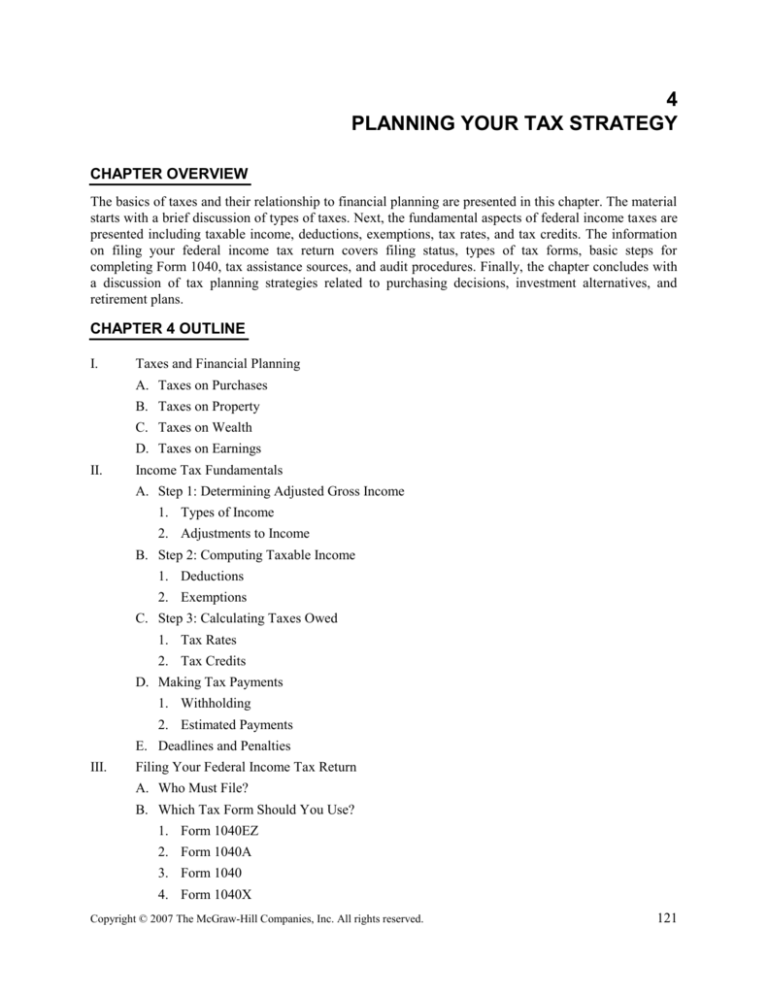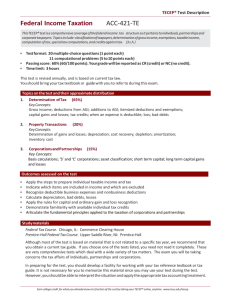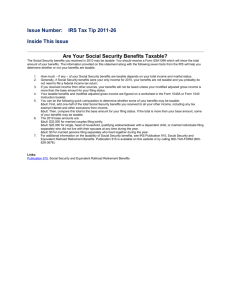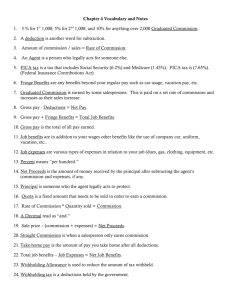
4
PLANNING YOUR TAX STRATEGY
CHAPTER OVERVIEW
The basics of taxes and their relationship to financial planning are presented in this chapter. The material
starts with a brief discussion of types of taxes. Next, the fundamental aspects of federal income taxes are
presented including taxable income, deductions, exemptions, tax rates, and tax credits. The information
on filing your federal income tax return covers filing status, types of tax forms, basic steps for
completing Form 1040, tax assistance sources, and audit procedures. Finally, the chapter concludes with
a discussion of tax planning strategies related to purchasing decisions, investment alternatives, and
retirement plans.
CHAPTER 4 OUTLINE
I.
Taxes and Financial Planning
A. Taxes on Purchases
B. Taxes on Property
C. Taxes on Wealth
D. Taxes on Earnings
II.
Income Tax Fundamentals
A. Step 1: Determining Adjusted Gross Income
1. Types of Income
2. Adjustments to Income
B. Step 2: Computing Taxable Income
1. Deductions
2. Exemptions
C. Step 3: Calculating Taxes Owed
1. Tax Rates
2. Tax Credits
D. Making Tax Payments
1. Withholding
2. Estimated Payments
E. Deadlines and Penalties
III.
Filing Your Federal Income Tax Return
A. Who Must File?
B. Which Tax Form Should You Use?
1. Form 1040EZ
2. Form 1040A
3. Form 1040
4. Form 1040X
Copyright © 2007 The McGraw-Hill Companies, Inc. All rights reserved.
121
C. Completing the Federal Income Tax Return
D. Filing State Income Tax Returns
IV.
Tax Assistance and the Audit Process
A. Tax Information Sources
1. IRS Services
2. Tax Publications
3. The Internet
B. Tax Preparation Software
C. Electronic Filing
D. Tax Preparation Services
1. Types of Tax Services
2. Evaluating Tax Services
3. Tax Service Warnings
E. What If Your Return Is Audited?
1. Who Gets Audited?
2. Types of Audits
3. Your Audit Rights
V.
Tax Planning Strategies
A. Consumer Purchasing
1. Place of Residence
2. Consumer Debt
3. Job-Related Expenses
4. Health Care Expenses
B. Investment Decisions
1. Tax-Exempt Investments
2. Tax-Deferred Investments
3. Self-Employment
4. Children’s Investments
C. Retirement Plans
1. Traditional IRA
2. Roth IRA
3. Education IRA
4. Keogh Plan
5. 401(K) Plan
D. Changing Tax Strategies
122
Copyright © 2007 The McGraw-Hill Companies, Inc. All rights reserved.
CHAPTER 4 LECTURE OUTLINE
I. TAXES AND FINANCIAL PLANNING (p. 106)
Common goals related to tax planning include:
knowing current tax laws
maintaining complete records
making financial decisions that can reduce your tax liability
The principal purpose of taxes is to finance government activities.
Taxes on Purchases (p. 106)
State and local sales taxes are added to the purchase price of products.
An excise tax is imposed on specific goods and services, such as gasoline, cigarettes,
alcoholic beverages, tires, air travel, and telephone service.
Taxes on Property (p. 106)
The real estate property tax is based on the value of land and buildings.
Personal property taxes on the value of automobiles, boats, furniture, and farm
equipment are imposed in some areas
Taxes on Wealth (p. 106)
An estate tax is imposed on the value of an individual’s property at the time of his or her
death.
An inheritance tax is levied on the value of property bequeathed by a deceased
individual.
Gift amounts greater than $11,000 are subject to federal tax.
Taxes on Earnings (p. 107)
Social Security taxes are used to finance the retirement, disability, and life insurance
benefits of the federal government’s social security program.
Income tax is the major financial planning aspect of taxes for most individuals. In
addition to federal income tax, all but seven states also have a state income tax.
Copyright © 2007 The McGraw-Hill Companies, Inc. All rights reserved.
123
CHAPTER 4 LECTURE OUTLINE
II. INCOME TAX FUNDAMENTALS (p. 107)
The process of determining your federal income tax involves computing taxable income,
calculating the amount of tax owed, and comparing this amount with income tax
payments withheld or made during the year.
Step 1: Determining Adjusted Gross Income (p. 107)
Taxable income is the net amount of income, after allowable deductions, on which tax is
computed.
Earned income is money received by an individual for personal effort such as wages,
salary, commission, fees, tips, or bonuses.
Investment income (also called portfolio income) is money received in the form of
dividends or interest.
Passive income is the result of business activities in which you do not actively
participate, such as a limited partnership.
An exclusion is an amount not included in gross income, such as foreign income when
working in another country.
Tax-exempt income is income not subject to tax.
Tax-deferred income refers to income that will be taxed at a later date.
Adjusted gross income (AGI) is gross income after certain reductions have been made.
Step 2: Computing Taxable Income (p. 109)
124
A deduction is an amount subtracted from adjusted gross income to arrive at taxable
income. Every taxpayer receives at least the standard deduction—a set amount on
which no tax is paid.
Many individuals qualify for more than the standard deduction.
Itemized deductions are expenses that a taxpayer is allowed to deduct from adjusted
gross income; these include:
medical and dental expenses above a certain amount
certain state and local taxes
certain interest payments such as home mortgage
contributions
casualty and theft losses based on certain restrictions
moving expenses under certain conditions
certain job-related and miscellaneous expenses
Copyright © 2007 The McGraw-Hill Companies, Inc. All rights reserved.
CHAPTER 4 LECTURE OUTLINE
An exemption is a deduction from adjusted gross income for yourself, your spouse, and
qualified dependents.
Step 3: Calculating Taxes Owed (p. 112)
Taxable income is the basis for the amount of your income tax. The use of tax rates and
the benefits of tax credits are the final phase of the tax computation process.
Use your taxable income in conjunction with the appropriate tax table or tax schedule.
The marginal tax rate refers to the rate used to calculate tax on your last (and next)
dollar of taxable income.
The average tax rate is based on the total tax due divided by your taxable income.
A tax credit is an amount subtracted directly from the amount of taxes owed.
Making Tax Payments (p. 113)
The pay-as-you-go system, which was started in 1943, requires an employer to deduct an
amount for federal income tax from your pay and send it to the government. The
withheld amount is based on the number of exemptions and expected deductions.
The W-2 form reports your annual earnings and the amounts that have been deducted for
federal income tax, social security, and, if applicable, state income tax.
Students and other low-income individuals may file for exemption from withholding if
they paid no federal income tax last year and do not expect to pay any in the current year.
People with income from savings, investments, independent contracting, royalties, and
lump-sum payments from pensions or retirement plans may be required to make tax
payments during the year.
Deadlines and Penalties (p. 115)
Most people are required to file their federal income tax return each April 15. If you are
not able to file on time, Form 4868 can be used to obtain an automatic four-month
extension. This extension is for the 1040 form and other documents, but it does not delay
your payment liability.
Copyright © 2007 The McGraw-Hill Companies, Inc. All rights reserved.
125
CHAPTER 4 LECTURE OUTLINE
III. FILING YOUR FEDERAL INCOME TAX RETURN (p. 115)
The annual submission of your federal income tax requires several decisions and
activities.
Who Must File? (p. 115)
Every citizen or resident of the United States and every U.S. citizen who is a resident of
Puerto Rico is required to file a federal income tax return if his or her income is above a
certain amount.
The five filing status categories are:
single
married filing joint return
married filing separate return
head of household
qualifying widow or widower
Which Tax Form Should You Use? (p. 115)
You may use Form 1040EZ if you are single and claim only your own exemption; if your
income consisted only of wages, salaries, and tips and not more than $400 of interest; if
your taxable income is less than $50,000; and if you do not itemize deductions or claim
any adjustments to income or any tax credits.
The Form 1040A would be used by individuals who have less than $50,000 in taxable
income from wages, salaries, tips, unemployment compensation, interest, or dividends;
on this form you can report a deduction for individual retirement account (IRA)
contributions and a tax credit for child care and dependent care expenses.
Form 1040 is an expanded version of Form 1040A that includes sections for all types of
income and makes it possible to itemize your deductions.
Form 1040X is used to amend a previously filed tax return.
Completing the Federal Income Tax Return (p. 116)
The major sections of Form 1040 are:
1. filing status and exemptions
2. income
3. adjustments to income
4. tax computation
5. tax credits
6. other taxes
7. payments
CHAPTER 4 LECTURE OUTLINE
8. refund or amount owed
9. your signature
Filing State Income Tax Returns (p. 118)
126
All but seven states have a state income tax. States usually require income tax returns to
be filed when your federal tax return is due.
Copyright © 2007 The McGraw-Hill Companies, Inc. All rights reserved.
CHAPTER 4 LECTURE OUTLINE
IV. TAX ASSISTANCE AND THE AUDIT PROCESS
(p. 120)
Tax Information Sources (p. 120)
The Internal Revenue Service assists taxpayers through books and other publications,
recorded phone messages with tax information, a toll-free hotline to answer questions,
and a walk-in tax assistance service.
Other tax guides available from various organizations are published each year.
The Internet provides many information sources related to tax planning and tax form
preparation.
Tax Preparation Software (p. 123)
A spreadsheet program can be very helpful for maintaining and updating tax data on
various income and expense categories.
Specialized programs for preparing your federal income tax return are also available.
Electronic Filing (p. 123)
In recent years, the IRS has made online filing easier and less expensive. Through the
Free File Alliance, online tax preparation and e-filing is available free to millions of
taxpayers. This partnership between the IRS and the tax software industry encourages
more e-filing. The online filing process involves the following steps:
Step 1. Go to the “Free File” page at www.irs.gov.
Step 2. Determine your eligibility with a particular company. Many of the services are
limited to lower-income taxpayers, and some offer: "No restrictions. Everyone qualifies."
Step 3. Connect to the company's web site to begin the preparation of your tax return.
Step 4. Use the company’s online software to prepare your return.
Taxpayers who do not qualify for the Free File Alliance program may still be able to
file online for a nominal fee.
Taxpayers who use the Free File Alliance are cautioned to be careful consumers. A
company may attempt to sell other financial products to inexperienced taxpayers.
Copyright © 2007 The McGraw-Hill Companies, Inc. All rights reserved.
127
CHAPTER 4 LECTURE OUTLINE
Tax Preparation Services (p. 124)
The sources available for professional tax assistance include:
tax services
enrolled agents, who are government-approved tax experts
accountants
attorneys
When planning to use a tax preparation service, consider these factors:
128
What training and experience does the tax professional possess?
How will the fee be determined? (Avoid preparers who earn a percentage of your
refund.)
Does the preparer suggest you report various deductions that might be questioned?
Will the preparer represent you if your return is audited?
Is tax preparation the main business activity, or does it serve as a front for selling other
financial products and services?
Copyright © 2007 The McGraw-Hill Companies, Inc. All rights reserved.
CHAPTER 4 LECTURE OUTLINE
What If Your Return Is Audited? (p. 125)
The IRS reviews all returns to make sure that they have been properly completed. If you
made an error, your tax is automatically refigured and you will receive a bill or a
refund.
A tax audit is a detailed examination of your tax return by the IRS.
The types of audits are:
the correspondence audit to clarify or document minor questions
the office audit in which you must visit an IRS office to clarify some aspect of your
return
the field audit involves an IRS agent visiting your home or place of business
When you receive an audit notice, you have the right to have more time to prepare.
Also, ask the IRS for clarification of items being questioned. When being audited, the
following suggestions can be helpful:
decide if you will bring your tax preparer, accountant, or lawyer
be on time to your appointment; bring only relevant documents
answer the IRS agent’s questions clearly and completely
present substantiating records and receipts in a logical, calm, and confident manner, and
maintain a positive attitude that avoids hostility
make sure the information you present is consistent with the tax law
keep your answers aimed at the auditor’s questions. Be as brief as possible; you can
never tell an auditor too little.
Copyright © 2007 The McGraw-Hill Companies, Inc. All rights reserved.
129
CHAPTER 4 LECTURE OUTLINE
V. TAX PLANNING STRATEGIES (p. 126)
Tax avoidance is the use of legitimate methods to reduce one’s taxes.
Tax evasion is the use of illegal actions to reduce one’s taxes.
Consumer Purchasing (p. 127)
Owning a home is one of the best tax shelters available to most individuals. Real estate
property taxes and mortgage interest are deductible as itemized deductions.
The interest on home equity loans is deductible, when these loans are used to buy a car,
consolidate credit card debts, or finance other personal expenses.
A variety of work expenses, such as union dues, certain travel and education costs, and
business tools, may be included as itemized deductions.
Flexible spending accounts (FSA), also called health savings accounts and expense
reimbursement accounts, reduce taxable income when paying for medical expenses or
child-care costs.
Workers are allowed to put pre-tax dollars into these employer-sponsored programs.
These “deposits” result in a lower taxable income. Then, the funds in the FSA may be
used to pay for various medical expenses and dependent-care costs.
A drawback of the FSA is that any account funds must be used to pay for expenses
incurred before year's end or the money is lost.
Investment Decisions (p. 128)
Interest income from municipal bonds, which are issued by state and local governments
and other tax-exempt investments, is not subject to federal income taxes.
Tax-deferred investments include:
tax-deferred annuities
Section 529 savings plans to set aside money for a child’s education
retirement plans such as IRA, Keogh, or 401(k) plans
CHAPTER 4 LECTURE OUTLINE
130
Capital gains, profits from the sale of a capital asset such as stocks, bonds, or real
estate, are also tax deferred; you do not have to pay the tax on these profits until the asset
is sold. Long-term capital gains (on investments held more than a year) are taxed at a
lower rate. Certain assets, however, such as art, antiques, stamps, and other collectibles,
are still taxed at the pre-1997 capital gains rate—28 percent.
Short-term capital gains (on investments held for less than 12 months) are taxed as
ordinary income (See Financial Planning Calculations box on page 130).
Copyright © 2007 The McGraw-Hill Companies, Inc. All rights reserved.
CHAPTER 4 LECTURE OUTLINE
The sale of an investment for less than its purchase price is, of course, a capital loss.
Capital losses can be used to offset capital gains and up to $3,000 of ordinary income.
Unused capital losses may be carried forward into future years to offset capital gains or
ordinary income up to $3,000 per year.
Retirement Plans (p. 129)
A major tax strategy of benefit to working people is the use of tax-deferred retirement plans
such as individual retirement accounts (IRAs), Keogh plans, and 401(k) plans.
A traditional IRA allows contributions up to $2,000 per year with earnings from the
plans not taxed until they are withdrawn. Today, a regular IRA deduction is available
only to people who do not participate in employer-sponsored retirement plans and have
an adjusted gross income under a certain amount.
In general, amounts withdrawn from deductible IRAs are included in gross income. An
additional 10 percent penalty is usually imposed on withdrawals made before age 59½
unless the withdrawn funds are on account of death or disability, for medical expenses,
or for qualified higher education expenses.
In 1997, Congress created the Roth IRA (also called the IRA Plus). While the $3,000
annual contribution to this plan is not tax deductible, the earnings on the account are tax
free after five years. The funds from the Roth IRA may be withdrawn after age 59½, if
the account owner is disabled, for educational expenses, or for the purchase of your first
home. As with the regular IRA, the Roth IRA is limited to people with an adjusted gross
income under a certain amount.
The Education IRA is designed to assist parents to save for the college education of
their children. Once again, the annual contribution (limited to $2,000) is not tax
deductible and is limited to taxpayers with an adjusted gross income under a certain
amount. However, as with the Roth IRA, the earnings accumulate tax-free.
If you are a self-employed person and own your own business, you can establish a
Keogh plan. This retirement plan, also called an HR10 plan, may combine a profitsharing plan and a money purchase pension plan of other investments.
CHAPTER 4 LECTURE OUTLINE
The part of the tax code called 401(k) authorizes a tax-deferred retirement plan
sponsored by an employer. This plan allows you to contribute a greater tax-deferred
amount (a maximum of $12,000 for 2003; gradually increasing to $15,000 in 2006) than
you can contribute to an IRA. However, most companies set a limit on your contribution,
such as 15 percent of your salary. Many employers provide a matching contribution in
their 401(k) plans.
Changing Tax Strategies (p. 131)
Each year, the IRS changes the tax form and filing procedures. In addition, Congress
frequently passes legislation that changes the tax code. These changes require that you
regularly determine how to best take advantage of the tax laws for your personal
financial planning.
Copyright © 2007 The McGraw-Hill Companies, Inc. All rights reserved.
131





